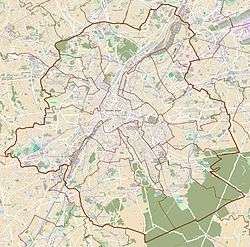Royal Belgian Institute of Natural Sciences
| Muséum des sciences naturelles de Belgique/Koninklijk Belgisch Instituut voor Natuurwetenschappen | |
|
The entrance of the new museum building. | |
 Location within Brussels | |
| Established | 1846 |
|---|---|
| Location |
Rue Vautier 29 B-1000 Brussels |
| Coordinates | 50°50′13″N 4°22′34″E / 50.837056°N 4.376167°E |
| Type | Natural history museum |
| Director | Camille Pisani |
| Public transit access | Brussels-Luxembourg railway station, bus stop Museum (bus 34 or 80), Luxembourg, Idalie (bus 38 or 95) |
| Nearest car park | Yes |
| Website |
www |
The Royal Belgian Institute of Natural Sciences (or Museum of Natural Sciences) is a museum in the Belgian capital of Brussels dedicated to natural history. Its most important pieces are 30 fossilized Iguanodon skeletons, which were discovered in 1878 in Bernissart. The dinosaur hall of the museum is the world's largest museum hall completely dedicated to dinosaurs. Another famous piece is the Ishango bone, which was discovered in 1960 by Jean de Heinzelin de Braucourt.
Like in most museums, there is a research department and a public exhibit department.
History
The museum was founded on 31 March 1846 as a descendant of the Musée de Bruxelles of 1802. It was based on the collection established by Prince Charles Alexander of Lorraine, which dated from the 18th century. Bernard du Bus de Gisignies, became the first director of the museum in 1846. On this occasion he donated 2474 birds from his own collection to the museum. In 1860, during the construction of new fortifications around Antwerp, several fossils were found which were mainly from whales. The museum also obtained the skeletons from a bowhead whale (Balaena mysticetus) and a young blue whale (Balaenoptera musculus), which are still on display in the museum. In 1860 the skeleton of a mammoth was found near Lier and was brought to the museum (on display since 1869). At that time the only other skeleton of a mammoth was on display in the museum of Saint Petersburg (Russia). In 1878, the largest find of Iguanodon fossils to date occurred in a coal mine at Bernissart in Belgium. At least 38 Iguanodon individuals were uncovered, of which 30 are on display since 1882.
Since 2007, a completely renovated and enlarged dinosaur hall (the Janlet wing) of 4580 m2 is the largest dinosaur hall in the world.
Permanent exhibitions

- The Dinosaur hall: with the world famous Iguanodon skeletons (30 almost complete skeletons)
- Of Men and Mammoths: about the evolution of man and about the last ice age in western Europe.
- The Mammal Gallery: recent and extinct mammals, including a thylacine.
- The North and South Pole: a view of two different worlds in a (plexi)glass tunnel.
- The Whale Hall: skeletons of whales, dolphins, walruses, sirenians, seals... A small part of the hall is devoted to the whales' role in the economy and their sacrifices to it.
- The Shell Gallery houses a tropical aquarium and a complete survey of the lower classes of invertebrates. The nearby North Sea Discovery Room takes you on an interactive tour around beach and sea life at the Belgian coast. The entire collection consists of 9 000 000 specimens and is one of the three biggest shell collections in the world. A great deal was collected by Philippe Dautzenberg.
- The Insect Gallery: insects, spiders, crustaceans and other arthropods, including a vivarium with living specimens. The collection consists of 15 000 000 specimens of which ten thousands are holotypes of great scientific value.
- The Mineral Gallery: crystals, cut gems, meteorites and precious bits of moon rock.
- The Ishango bone, a prehistoric bone counting tool
Next to these permanent exhibitions, there are also temporary exhibitions which are always highly interactive.
See also
- Belgian Federal Science Policy Office (BELSPO)
- Geological Survey of Belgium
- Edmond de Sélys Longchamps
- Lier mammoth
External links
| Wikimedia Commons has media related to Royal Belgian Institute of Natural Sciences. |
- The museum's official website
- Visiting Dinosaurs at the Museum of Natural Sciences, Brussels, Belgium
Coordinates: 50°50′13.4″N 4°22′34.2″E / 50.837056°N 4.376167°E